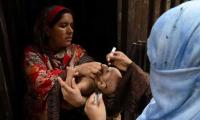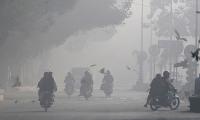PESHAWAR: Recalling devastation caused by the previous flood that had washed away several villages in Chitral district, 60-year old Noor Alam Baig fears another calamity as his village is located in the vicinity of the glaciers that often cause outburst floods.
A resident of the remote Arkari valley, Alam Baig has witnessed many small and large scale floods in his life. Having a population of about 1,200 families, Arkari valley is located some 80 kilometres away from Chitral city towards Afghanistan’s Badakhshan province. The last devastating flood in July 2015 had washed away dozens of houses and agricultural lands, destroyed standing crops and killed human beings and animals in Arkari. “As we are located in the remote corner of Chitral, the government and non-governmental organisations could not reach us in time during a calamity due to the dilapidated roads and poor communications network,” another resident Azeem Khan told this scribe during a recent visit to Arkari valley.
The visit was facilitated by an organisation working for raising awareness about the risk and devastation of glacial lakes outburst floods (Glof) in Chitral and four other districts of Khyber Pakhtunkhwa. The project is jointly funded by United Nations Development Programme (UNDP) and Green Climate Fund. “This is the second phase of Glof in Chitral and adjacent Gilgit-Baltistan where the local communities are helped to identify and manage risks associated with the outburst floods and other related impacts of the climate change,” said Fahad Bangash, provincial coordinator of Glof-11 in Khyber Pakhtunkhwa.
He added that all the 10 districts of Gilgit-Baltistan and four KP districts including Chitral, Upper Dir, Swat and Manserha are included in the Glof project and steps were being taken for scaling up community-based early warning system and long-term measures for adaptive capacity.
The melting of glaciers poses a more immediate threat as it forms lakes which overrun their capacity, causing outburst floods. Many villages and towns located in the vicinity of the glaciers are most vulnerable to these floods and the inhabitants face constant risks due to the climatic phenomenon.
Fahad Bangash said that some 7,000 glaciers are located in Pakistan, of which over 5,000 are counted in Khyber Pakhtunkhwa and Gilgit-Baltistan. He added that there are more than 3,000 glacial lakes in Khyber Pakhtunkhwa and Gilgit-Baltistan, including about 33 identified as potentially hazardous.
“Due to climatic change, sometimes glacial lakes are formed within months in remote mountains and cause flash floods in the downtowns,” he said. He pointed out that the outburst floods are so immediate that they could seldom be stopped or controlled. The residents of Arkari valley said that the main road between Arkari and Chitral city should be built while protection walls should be constructed on both sides of the river and drains so that their houses and agriculture lands could be protected from floods. The administrator of Provincial Disaster Management Authority (PDMA) for Malakand division, Sardar Zeb Khan, told The News that provincial Secretary Relief and Rehabilitation Abid Majeed had recently visited the area and approved a regional office of the PDMA in Chitral in order to assist the calamity-hit people at the earliest.
The Khyber Medical University building in Peshawar. — KMU Website/FilePESHAWAR: Khyber Medical University ,...
Advisor to the Chief Minister on Information Barrister Muhammad Ali Saif addresses an event on June 13, 2024. —...
A representational image of oil tankers parked at a terminal. — Online/FilePESHAWAR: The Khyber Pakhtunkhwa chapter...
Folk singer singing a traditional song at the closing ceremony of Lok Mela 2024 on November 17, 2024. — Screengrab...
KPJA Director General Jehanzeb Shinwari addresses an event on November 12, 2024. — Facebook@kpjapeshawar PESHAWAR:...
University of Engineering and Technology Peshawar seen in this image. — Facebook@UETPeshawarOfficial/File PESHAWAR:...







